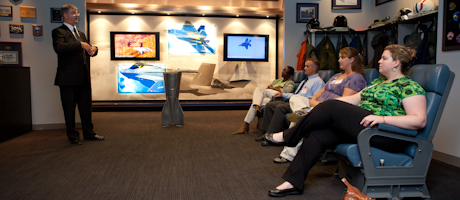By Laura Donnelly-Smith
High school science teacher Jennifer Doiron sat in the F-35 Lightening II cockpit, her right hand gripping the control column and her eyes focused on the display screen, where indicators blinked back her altitude, speed and position. Her mission seemed straightforward: land the fighter plane safely on an aircraft carrier located a few miles ahead.
But Ms. Doiron, who is more accustomed to teaching environmental science, wasn’t sure the video games she’d played with her two children had adequately prepared her for this moment. She eased the control column forward gingerly and watched the screen as she approached the carrier, focusing on keeping the plane upright and on course. “You’re doing great,” said her guide, Mike Otterblad, a fighter pilot expert. With the runway looming ahead, Ms. Doiron guided the plane down to a mostly smooth landing. “Very nice job!” Mr. Otterblad said. “Now let’s try something else.”
Ms. Doiron was, of course, not piloting an actual F-35. She was using a high-tech simulator in Lockheed Martin’s Flight Demonstration Center in Crystal City, Va. She and three other Virginia middle and high school educators visited the center as part of the GW Teachers in Industry Project (GWTIP), a partnership between the university’s Virginia Science and Technology Campus in Ashburn, Va., and the Loudoun and Prince William County public schools. The program, in its third year, pairs educators with local businesses for externships that emphasize real-world applications for the material the teachers cover in the classroom.
For 2011, GWTIP was funded primarily through a grant from Lockheed Martin, with additional support from the Verizon Foundation. Participating school districts also provided stipends for the educators selected to participate. The three-week program included 17 middle and high school teachers from 11 different schools. After a two-day orientation at the Virginia Science and Technology Campus, the teachers split into interdisciplinary groups to cycle between two externship locations each. In between and after the externships, the groups reconvened to discuss curriculum and develop “educational transfer plans” that they shared with their business and industry hosts at the program’s conclusion.
“Our goal is to offer teachers exposure to the most current workplace practices, tools, information and workforce trends in order to best equip their students to compete and succeed,” said Janet Schiavone, GWTIP codirector and an adjunct professor in GW’s Graduate School of Education and Human Development.
Externship locations for 2011 included, in addition to Lockheed Martin, Inova Loudoun Hospital, Loudoun Water, REHAU North America, Telos Corporation, Fortessa, Inc., Prototype Productions, Inc., Dulles International Airport and TASC, Inc. Teams visiting these locations learned, for example, how wastewater can be recycled into clean water, how cybersecurity systems defend global networks and how the construction industry is adopting “green” practices. Educators later worked in groups with peers from the same or similar fields to identify the skills and competencies gained in their externships and develop classroom activities and lesson plans around these skills.
Ms. Doiron, who teaches at Parkview High School in Sterling, Va., said her experience in the F-35 simulator helped reinforce that her students need opportunities to actively try different solutions to problems, even if they sometimes fail. “Kids are used to working to get the right answer,” she said. “But in doing science, nine times out of 10, you get the wrong answer, but it teaches you how to think.”
Although the GWTIP program was piloted in 2009 with primarily STEM (science, technology, engineering and mathematics) educators, industry partners later requested that the program also include English and language arts educators, said Nicole Kezmarsky, who teaches calculus at Loudoun County High School and has participated in the program since its inception. As a “mentor teacher” this summer, Ms. Kezmarsky helped newcomers get the most out of their site visits. “Businesses have started using the acronym STEAM instead of STEM because they want to incorporate language arts,” she explained. “When they hire, they want people who are good communicators.”
For Paulette Garner, a language arts teacher at Parkside Middle School in Manassas, Va., a GWTIP program externship with Dulles International Airport provided valuable industry contacts for one of her classroom assignments: writing a business letter. “For my students, something as simple as knowing when to switch from casual to formal style is important,” she said. Employees from Dulles volunteered to exchange letters with Ms. Garner’s eighth-grade students, and some have even offered to come to her classroom to talk about on-the-job communication. “Oral communication is huge in my classroom—it’s one of the standards of learning. The contacts we’re developing through this program are wonderful,” she said.
Ms. Kezmarsky said that both she and her students benefit from her participation in GWTIP. Employees from network security firm Telos came to her classroom last year to talk about real-world math applications, for example. “In this program, you see the ways people use the skills the kids really need to know. I teach AP calculus, so these students are our future engineers.”
And as a teacher, she enjoys the exposure to new technology and the collaboration with educators in other fields. “This is the best professional development experience I could have dreamed of,” she said. “It keeps my ideas fresh.”


